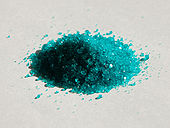Nickel is considered corrosion-resistant, but it will slowly oxidize
by air at room temperatures. It was used
for plating iron and brass, coating chemistry equipment and manufacturing
certain alloys that retain a high silvery polish. About 9% of nickel production today is still used
for corrosion- resistant plating. It’s
also been used to make coins, but in recent years is being replaced with
cheaper metals.
Nickel most often occurs in combination with iron and Sulfur. Nickel is commonly found in iron meteorites. Australia and New Caledonia have the largest
reserves of nickel.
Nickel coins - pic courtesy of Wilkipedia
Aside from some very early coins, nickel wasn’t a component
of coins until the mid-19th century.
Nickel pic courtesy of Wikipedia
About two million tons of nickel is produced annually
worldwide. The Philippines, Indonesia, Russia,
Canada and Australia are the world’s largest producers of nickel.
Hydrated nickel sulfate crystals - pic courtesy of Wikipedia
Nickel is used in stainless steel, rechargeable
batteries, electric guitar strings, coins, and plating on plumbing fixtures.
Nickel is the top confirmed contact allergen worldwide,
partly due to its use in jewelry for pierced ears. Many earrings are now made without nickel, or
with a low-release nickel. Contact dermatitis
is marked by itchy, red skin and affects nearly 72.29 million people.




No comments:
Post a Comment
Thank you for stopping by to read and
comment on my posts. I appreciate it.
Sunni